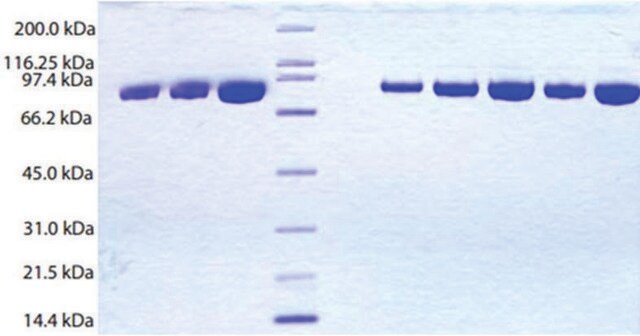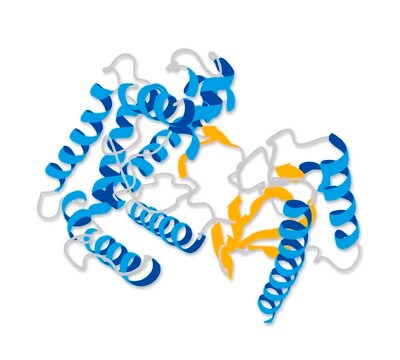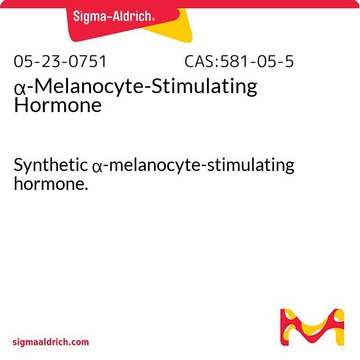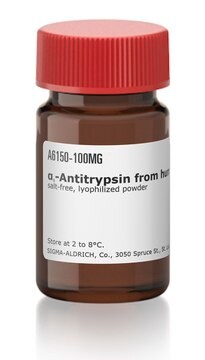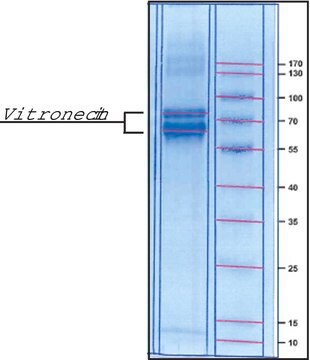SRP3318
C1 Inhibitor Peptide
≥95% (HPLC), lyophilized powder, human recombinant, expressed in CHO cells
Sinonimo/i:
C1inh, Plasma protease C1 inhibitor, Serpin G1
Autenticatiper visualizzare i prezzi riservati alla tua organizzazione & contrattuali
About This Item
Codice UNSPSC:
12352202
NACRES:
NA.32
Prodotti consigliati
Nome del prodotto
C1 Inhibitor human, recombinant, expressed in CHO cells, ≥95% (SDS-PAGE), ≥95% (HPLC)
Origine biologica
human
Ricombinante
expressed in CHO cells
Saggio
≥95% (HPLC)
≥95% (SDS-PAGE)
Stato
lyophilized
Potenza
≤2.6 nM IC50
PM
52.8 kDa
Confezionamento
pkg of 200 μg
Impurezze
endotoxin, tested
N° accesso UniProt
Condizioni di spedizione
wet ice
Temperatura di conservazione
−20°C
Informazioni sul gene
human ... SERPING1(710)
Descrizione generale
Plasma protease C1 inhibitor is a member of the serpin family of structurally related proteins. Recombinant Human C1 inhibitor is a highly glycosylated glycoprotein containing 478 amino acid residues (52.8kDa), corresponding to amino acids 23-500 of the C1 inhibitor precursor, and is fully functional in its ability to inhibit the C1 complex. Glycosylated C1 inhibitor migrates at an apparent molecular weight of approximately 80-90kDa by SDS PAGE analysis under reducing conditions.
Azioni biochim/fisiol
Plasma protease C1 inhibitor is the primary regulator of the immune complement system. C1 inhibitor is a protease inhibitor that functions to inhibit the complement system in order to prevent over-activation or spontaneous activation. Inhibition is achieved by binding to and irreversibly inhibiting the C1r and C1s proteases of the C1 complex, which has the effect of shutting down all subsequent downstream events in the complement activation cascade. C1 inhibitor can also inhibit various other proteases, including Kallikrein, Factor XIa, and Factor XIIa. Deficiencies in C1 inhibitor are the primary cause of hereditary angioedema (HAE, hereditary angioneurotic edema), a disease characterized by edema in the respiratory and gastrointestinal tracts. In certain clinical situations, the direct administration of C1 inhibitor can be used to treat HAE and certain other conditions.
Stato fisico
Lyophilized from 10mM Sodium Phosphate, pH 7.5.
Ricostituzione
Centrifuge the vial prior to opening. Reconstitute in water to a concentration of 0.1-1.0 mg/ml. Do not vortex. This solution can be stored at 2-8°C for up to 1 week. For extended storage, it is recommended to further dilute in a buffer containing a carrier protein (example 0.1% BSA) and store in working aliquots at -20°C to -80°C.
Codice della classe di stoccaggio
11 - Combustible Solids
Classe di pericolosità dell'acqua (WGK)
WGK 3
Punto d’infiammabilità (°F)
Not applicable
Punto d’infiammabilità (°C)
Not applicable
Scegli una delle versioni più recenti:
Possiedi già questo prodotto?
I documenti relativi ai prodotti acquistati recentemente sono disponibili nell’Archivio dei documenti.
C1 inhibitor.
A E Davis et al.
Methods in enzymology, 223, 97-120 (1993-01-01)
C1-inhibitor deficiency and angioedema.
Carugati A
Molecular Immunology, 38(2-3), 161-173 (2001)
C1 Esterase Inhibitor (Human)
P & T : A Peer-Reviewed Journal for Formulary Management, 35, 2-3 (2010)
Sayani Mukherjee et al.
The Journal of neuroscience : the official journal of the Society for Neuroscience, 40(41), 7965-7979 (2020-09-06)
Microglia, a type of CNS immune cell, have been shown to contribute to ethanol-activated neuronal death of the stress regulatory proopiomelanocortin (POMC) neuron-producing β-endorphin peptides in the hypothalamus in a postnatal rat model of fetal alcohol spectrum disorders. We determined
In vivo biosynthesis of endogenous and of human C1 inhibitor in transgenic mice: tissue distribution and colocalization of their expression.
Vinci G
Journal of Immunology, 169(10), 5948-5954 (2002)
Il team dei nostri ricercatori vanta grande esperienza in tutte le aree della ricerca quali Life Science, scienza dei materiali, sintesi chimica, cromatografia, discipline analitiche, ecc..
Contatta l'Assistenza Tecnica.